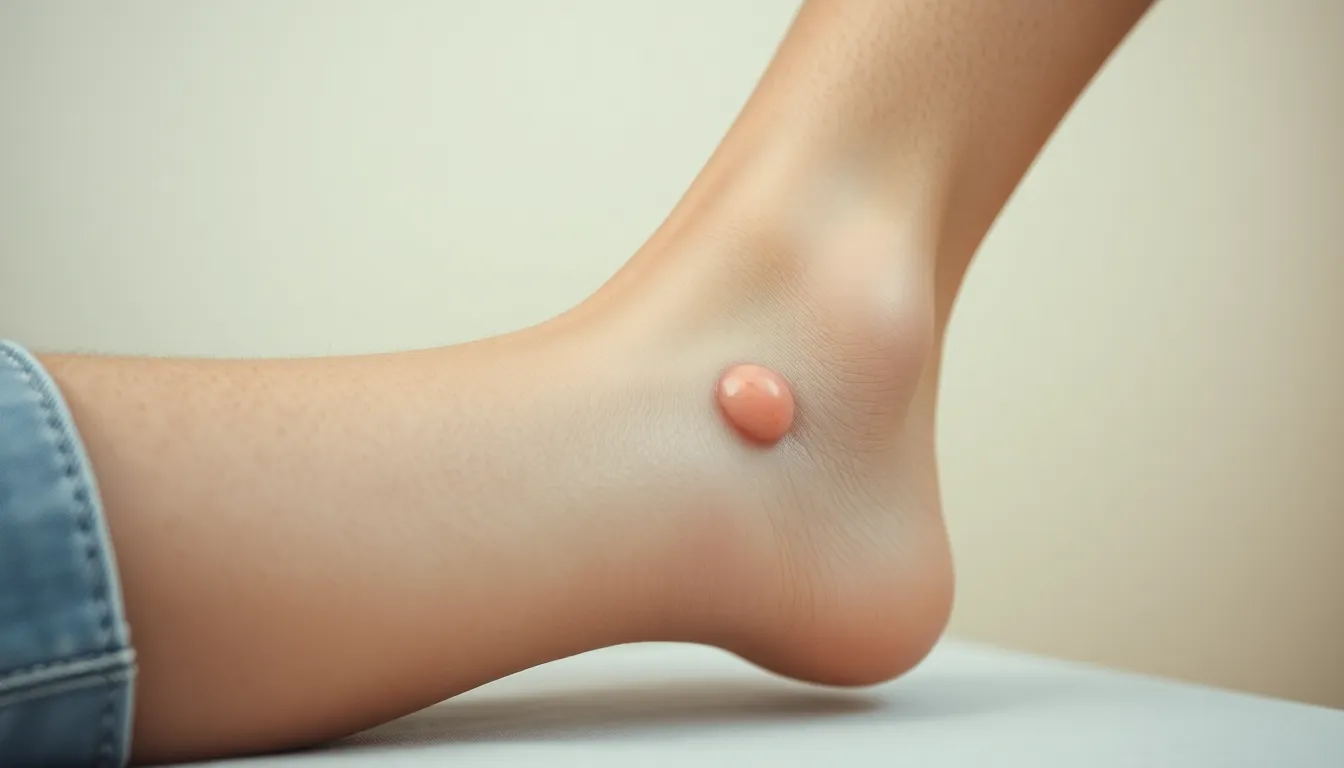Picture this: you’re lounging on the couch, flipping through channels, when you notice a hard lump under your skin on your leg. Suddenly, your leg feels like it’s auditioning for a horror movie. Is it a secret stash of snacks from last week? A mini rock concert happening beneath the surface? Fear not! While lumps can be alarming, they often have perfectly harmless explanations.
Table of Contents
ToggleOverview of Hard Lump Under Skin on Leg
A hard lump under the skin on the leg can arise from various conditions. Some common causes include lipomas, sebaceous cysts, and fibromas. Lipomas are soft, benign tumors made of fat cells, typically movable and painless. Sebaceous cysts contain a thick, oily substance and may appear on the surface of the skin. Fibromas are firm growths from fibrous tissue and can also be painless.
Injuries such as muscle strains or bruises can lead to localized swelling and create a lump. Inflammation can occur due to an infection or an allergic reaction, contributing to the formation of a hard lump. Other medical conditions like varicose veins or certain types of tumors may also present as lumps under the skin.
Monitoring the lump is essential for any changes. If the lump increases in size, changes in color, or becomes painful, seeking medical attention is vital. Healthcare professionals often perform physical examinations and may recommend imaging tests. These may include ultrasound or MRI scans to determine the exact nature of the lump.
Hard lumps can range from benign to serious, and understanding the underlying causes helps address concerns. Identifying associated symptoms, such as fever or redness, can guide further evaluation. Knowledge of the potential causes and treatments informs individuals about their condition. Seeking prompt medical advice supports appropriate management, ensuring peace of mind.
Possible Causes

Understanding the potential causes of a hard lump under the skin on the leg is crucial. Several conditions can lead to this symptom, ranging from benign to malignant.
Benign Conditions
Benign conditions often involve harmless growths. Lipomas represent one common example; these soft tumors arise from fat cells and usually feel movable. Sebaceous cysts, another frequent cause, contain thick, oily substances and often appear near hair follicles. Additionally, fibromas are firm growths composed of fibrous tissue, generally presenting no significant health risks. Injuries resulting in localized swelling or inflammation may also appear as hard lumps. Allergic reactions or infections can lead to similar changes in the skin.
Malignant Conditions
Malignant conditions demand careful consideration. Sarcomas appear as aggressive tumors that originate in connective tissues, which can include muscles or fat. In rare instances, lymphoma may manifest as lumps under the skin. Skin cancer, specifically melanoma, may also develop noticeable lesions. Surveillance is essential; any irregular changes may indicate a concerning issue. Early detection for these conditions typically leads to better outcomes through effective treatment options. Monitoring for symptoms such as rapid growth, persistent pain, or discoloration may guide appropriate actions.
Symptoms and Diagnosis
Identifying symptoms associated with a hard lump under the skin on the leg requires careful observation. Key changes like size increase, color variation, or tenderness can signal a need for further evaluation.
Physical Examination
During a physical examination, a healthcare provider palpates the lump to determine its texture, size, and tenderness. This assessment helps distinguish between benign and potentially harmful growths. Noticing whether the lump moves when pushed or feels fixed in place generates important information. Asking about medical history, previous injuries, or any accompanying symptoms guides the clinician’s evaluation process. This examination plays a pivotal role in deciding if further investigation is necessary.
Diagnostic Imaging
Diagnostic imaging utilizes tools like ultrasounds and MRIs to visualize the lump’s internal structure. An ultrasound efficiently provides real-time images, helping to assess fluid-filled cysts versus solid masses. MRIs deliver detailed pictures that reveal the lump’s exact location and relationship to surrounding tissues. Such imaging studies assist in determining whether the lump requires surgical intervention or can be managed conservatively. Overall, diagnostic imaging significantly contributes to accurate diagnosis and appropriate treatment planning.
Treatment Options
Treatment options for hard lumps under the skin on the leg vary based on the underlying cause. Both home remedies and medical treatments exist to address these lumps effectively.
Home Remedies
Home remedies can provide comfort for minor issues. Warm compresses applied to the lump may reduce swelling and alleviate discomfort. Keeping the area clean helps prevent infection. Over-the-counter pain relievers, like ibuprofen or acetaminophen, can ease pain if necessary. Essential oils, such as tea tree or lavender, possess anti-inflammatory properties and may aid healing when diluted and applied topically. Monitoring the lump’s condition remains essential; if changes occur, seeking professional advice is advisable.
Medical Treatments
Medical treatments address more serious or persistent conditions. Healthcare providers may recommend surgical removal for lipomas or cysts if they cause pain or discomfort. Corticosteroid injections can help reduce inflammation in some cases. If a lump indicates an infection, antibiotics may be necessary to treat the underlying issue effectively. Healthcare professionals often suggest imaging tests to determine the best course of action based on a patient’s specific situation. Regular follow-ups ensure proper monitoring and management of any underlying causes.
When to Seek Medical Attention
Observing changes in a hard lump on the leg can signal the need for medical attention. Monitor symptoms like rapid growth, persistent pain, or discoloration closely. If a lump enlarges noticeably within a few weeks, consulting a healthcare professional becomes essential.
In some instances, lumps accompanied by redness, warmth, or tenderness could indicate an infection. These symptoms suggest a more serious underlying issue, warranting urgent evaluation. Additionally, if someone experiences fever or chills alongside the lump, seeking immediate medical care is advisable.
Not all lumps are harmless. For example, if an individual notices a hard lump that feels fixed in place and moves minimally with pressure, this could raise concerns about malignancy, making a thorough assessment critical.
Seeking medical advice is also crucial if the lump changes color or develops irregular edges. These characteristics might indicate an abnormal growth pattern that needs further investigation. Furthermore, any new lump that appears spontaneously, especially in individuals with a history of skin cancer, should prompt an examination.
Healthcare providers often use physical examinations and imaging tests to determine the lump’s nature. They can effectively assess and provide necessary medical guidance based on clinical findings. Keep in mind that prompt intervention enhances treatment outcomes, making early medical visits important for addressing hard lumps under the skin.
Encountering a hard lump under the skin can be unsettling but understanding its potential causes is key to addressing any concerns. Most lumps are benign and can often be managed with simple home remedies or medical treatments when necessary.
It’s crucial to monitor any changes in size color or pain and to consult a healthcare professional if any alarming symptoms arise. Early detection and appropriate intervention can significantly improve outcomes. By staying informed and proactive individuals can navigate their health with confidence and peace of mind.

